Jihyung Moon
Analyzing Norm Violations in Live-Stream Chat
May 18, 2023



Abstract:Toxic language, such as hate speech, can deter users from participating in online communities and enjoying popular platforms. Previous approaches to detecting toxic language and norm violations have been primarily concerned with conversations from online forums and social media, such as Reddit and Twitter. These approaches are less effective when applied to conversations on live-streaming platforms, such as Twitch and YouTube Live, as each comment is only visible for a limited time and lacks a thread structure that establishes its relationship with other comments. In this work, we share the first NLP study dedicated to detecting norm violations in conversations on live-streaming platforms. We define norm violation categories in live-stream chats and annotate 4,583 moderated comments from Twitch. We articulate several facets of live-stream data that differ from other forums, and demonstrate that existing models perform poorly in this setting. By conducting a user study, we identify the informational context humans use in live-stream moderation, and train models leveraging context to identify norm violations. Our results show that appropriate contextual information can boost moderation performance by 35\%.
KLUE: Korean Language Understanding Evaluation
Jun 11, 2021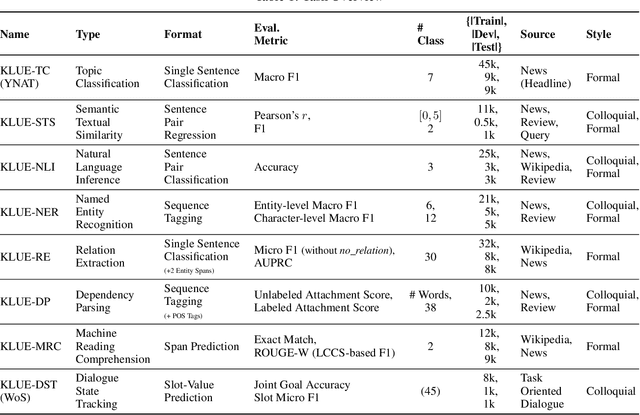

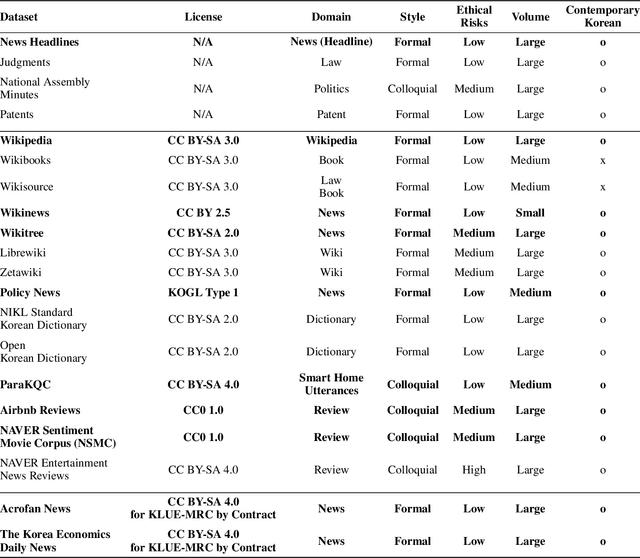
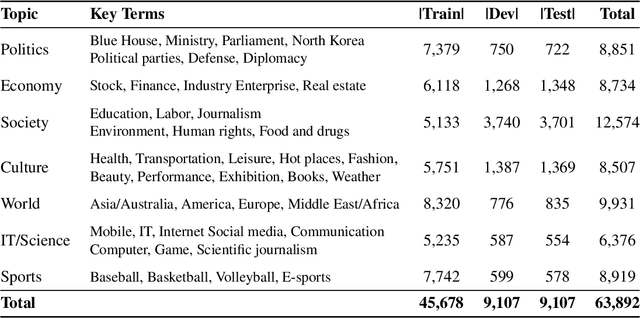
Abstract:We introduce Korean Language Understanding Evaluation (KLUE) benchmark. KLUE is a collection of 8 Korean natural language understanding (NLU) tasks, including Topic Classification, SemanticTextual Similarity, Natural Language Inference, Named Entity Recognition, Relation Extraction, Dependency Parsing, Machine Reading Comprehension, and Dialogue State Tracking. We build all of the tasks from scratch from diverse source corpora while respecting copyrights, to ensure accessibility for anyone without any restrictions. With ethical considerations in mind, we carefully design annotation protocols. Along with the benchmark tasks and data, we provide suitable evaluation metrics and fine-tuning recipes for pretrained language models for each task. We furthermore release the pretrained language models (PLM), KLUE-BERT and KLUE-RoBERTa, to help reproducing baseline models on KLUE and thereby facilitate future research. We make a few interesting observations from the preliminary experiments using the proposed KLUE benchmark suite, already demonstrating the usefulness of this new benchmark suite. First, we find KLUE-RoBERTa-large outperforms other baselines, including multilingual PLMs and existing open-source Korean PLMs. Second, we see minimal degradation in performance even when we replace personally identifiable information from the pretraining corpus, suggesting that privacy and NLU capability are not at odds with each other. Lastly, we find that using BPE tokenization in combination with morpheme-level pre-tokenization is effective in tasks involving morpheme-level tagging, detection and generation. In addition to accelerating Korean NLP research, our comprehensive documentation on creating KLUE will facilitate creating similar resources for other languages in the future. KLUE is available at https://klue-benchmark.com.
BEEP! Korean Corpus of Online News Comments for Toxic Speech Detection
May 26, 2020

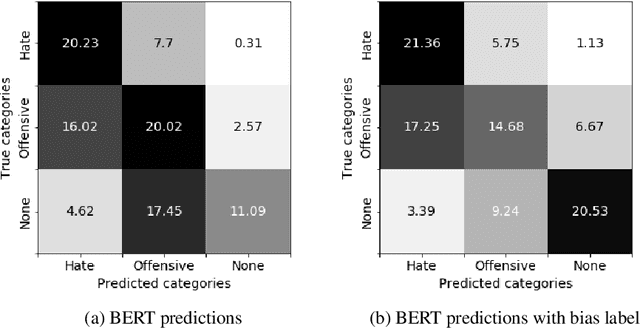
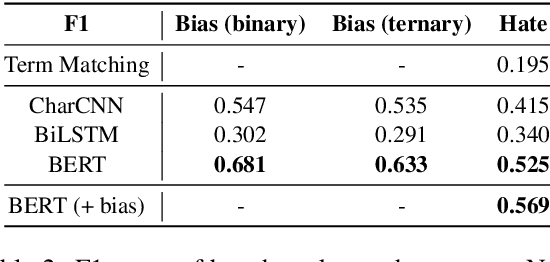
Abstract:Toxic comments in online platforms are an unavoidable social issue under the cloak of anonymity. Hate speech detection has been actively done for languages such as English, German, or Italian, where manually labeled corpus has been released. In this work, we first present 9.4K manually labeled entertainment news comments for identifying Korean toxic speech, collected from a widely used online news platform in Korea. The comments are annotated regarding social bias and hate speech since both aspects are correlated. The inter-annotator agreement Krippendorff's alpha score is 0.492 and 0.496, respectively. We provide benchmarks using CharCNN, BiLSTM, and BERT, where BERT achieves the highest score on all tasks. The models generally display better performance on bias identification, since the hate speech detection is a more subjective issue. Additionally, when BERT is trained with bias label for hate speech detection, the prediction score increases, implying that bias and hate are intertwined. We make our dataset publicly available and open competitions with the corpus and benchmarks.
Revisiting Round-Trip Translation for Quality Estimation
Apr 29, 2020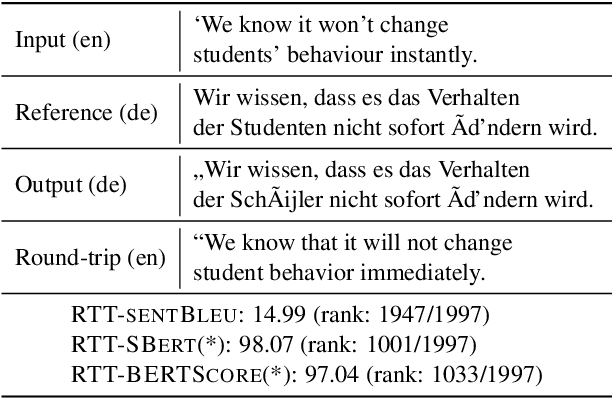
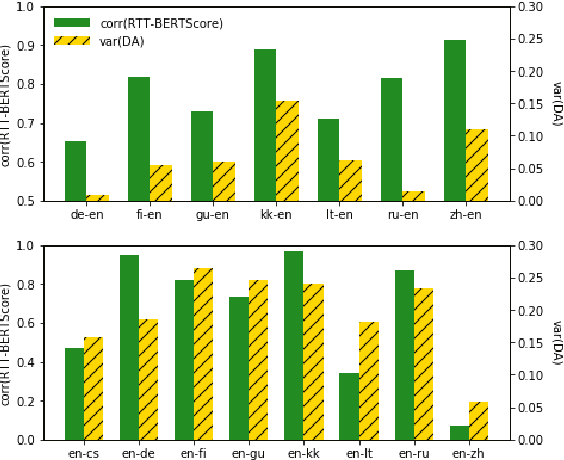

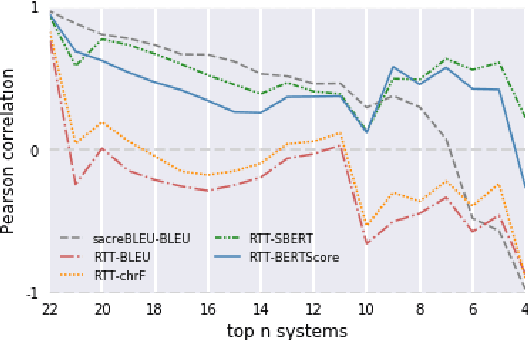
Abstract:Quality estimation (QE) is the task of automatically evaluating the quality of translations without human-translated references. Calculating BLEU between the input sentence and round-trip translation (RTT) was once considered as a metric for QE, however, it was found to be a poor predictor of translation quality. Recently, various pre-trained language models have made breakthroughs in NLP tasks by providing semantically meaningful word and sentence embeddings. In this paper, we employ semantic embeddings to RTT-based QE. Our method achieves the highest correlations with human judgments, compared to previous WMT 2019 quality estimation metric task submissions. While backward translation models can be a drawback when using RTT, we observe that with semantic-level metrics, RTT-based QE is robust to the choice of the backward translation system. Additionally, the proposed method shows consistent performance for both SMT and NMT forward translation systems, implying the method does not penalize a certain type of model.
Finding ReMO : A Simple Neural Architecture for Text based Reasoning
Jan 26, 2018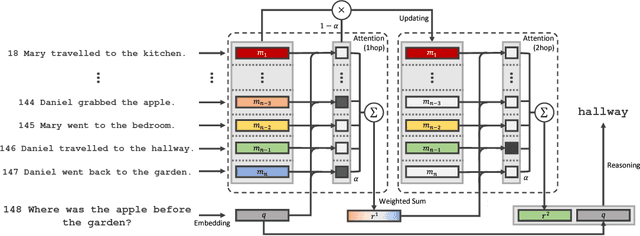
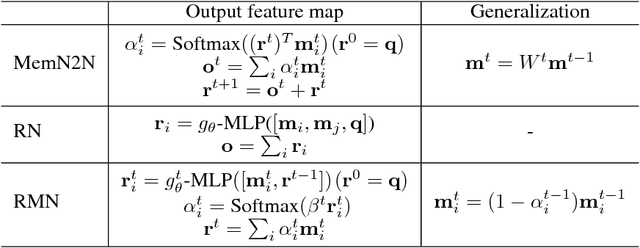

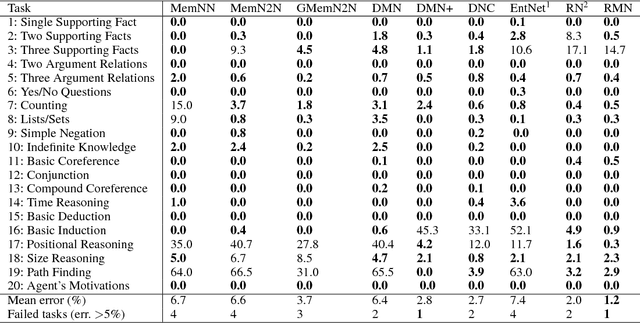
Abstract:To solve the text-based question and answering task that requires relational reasoning, it is necessary to memorize a large amount of information and find out the question relevant information from the memory. Most approaches were based on external memory and four components proposed by Memory Network. The distinctive component among them was the way of finding the necessary information and it contributes to the performance. Recently, a simple but powerful neural network module for reasoning called Relation Network (RN) has been introduced. We analyzed RN from the view of Memory Network, and realized that its MLP component is able to reveal the complicate relation between question and object pair. Motivated from it, we introduce which uses MLP to find out relevant information on Memory Network architecture. It shows new state-of-the-art results in jointly trained bAbI-10k story-based question answering tasks and bAbI dialog-based question answering tasks.
 Add to Chrome
Add to Chrome Add to Firefox
Add to Firefox Add to Edge
Add to Edge